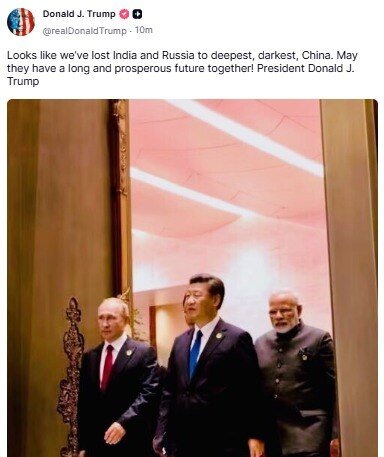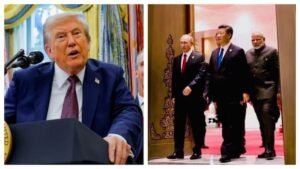Former President Trump recently posted a controversial image showing three world leaders standing together at an international summit. The photo features Indian Prime Minister Modi, Russian President Putin, and Chinese President Xi during their recent SCO Summit meeting. Trump’s caption declared that America has lost India and Russia to the influence of darkest China.
The Controversial Social Media Post Explained
The image Trump shared comes from the Shanghai Cooperation Organization summit where multiple world leaders gathered recently. You can see Modi, Putin, and Xi positioned closely together during official summit photography sessions. Trump’s commentary suggests these nations are forming stronger bonds that could challenge American global influence.
The former president’s choice of words sparked immediate debate across political and diplomatic circles worldwide. His description of China as the “darkest” nation reflects his administration’s confrontational approach toward Beijing. This language echoes previous statements about Chinese trade practices and military expansion efforts.
Political analysts note that Trump’s post comes during a period of shifting global alliances and power structures. The timing coincides with ongoing tensions between the United States and both Russia and China. Meanwhile, India maintains complex relationships with all three major powers while pursuing its national interests.
Understanding the SCO Summit Context
The Shanghai Cooperation Organization brings together major Asian nations for economic and security cooperation discussions annually. Russia and China serve as founding members while India joined as a full member in recent years. The organisation focuses on regional stability, trade partnerships, and security coordination among member states.
During this year’s summit, leaders discussed various topics, including:
- Regional security challenges and counterterrorism efforts
- Economic cooperation and trade facilitation measures
- Energy partnerships and infrastructure development projects
- Digital connectivity and technological collaboration initiatives
The summit provided opportunities for bilateral meetings between leaders beyond the formal organisational agenda items. Modi’s interactions with both Putin and Xi received significant media attention given current global tensions. These diplomatic engagements reflect India’s balanced approach to international relations and strategic partnerships.
Analysing Trump’s Claims About Lost Allies
Trump’s assertion that America has “lost” these nations oversimplifies complex international relationships that span decades. India maintains strong ties with the United States through various defence, technology, and trade partnerships. The Quad alliance including India, US, Japan, and Australia demonstrates continued strategic cooperation.
Russia’s relationship with America deteriorated significantly following various conflicts and sanctions regimes over recent years. The Ukraine situation further strained diplomatic ties between Moscow and Washington across multiple presidential administrations. Putin’s government has indeed moved closer to China through energy deals and military cooperation.
However, geopolitical experts argue that nations pursue their own interests rather than simply choosing sides permanently. India’s foreign policy emphasises strategic autonomy while maintaining beneficial relationships with multiple major powers. This approach allows Delhi to maximise economic and security benefits without exclusive alignment.
The Reality of Modern Diplomatic Relations
Contemporary international relations operate through complex networks rather than simple bilateral alliances or opposition blocs. You observe nations collaborating in some areas while competing in others, depending on specific issues. India works with America on technology while buying Russian energy and engaging China economically.
The SCO Summit represents just one forum among many where these leaders interact throughout the year. Modi also participates in G7 meetings, Quad summits, and bilateral visits with American officials regularly. These multiple engagement channels prevent any single meeting from defining entire bilateral relationship.
China’s Belt and Road Initiative has created economic ties with numerous nations, including traditional American allies. However, many countries accept Chinese investment while maintaining security partnerships with the United States. This pragmatic approach reflects modern diplomatic realities rather than permanent alliance shifts.
Impact on US Foreign Policy Strategy
Trump’s comments highlight ongoing debates about American diplomatic effectiveness in maintaining global influence and partnership networks. The post suggests frustration with perceived losses of strategic allies to Chinese influence operations. This perspective reflects broader concerns about China’s growing economic and military power worldwide.
Current American foreign policy emphasises strengthening partnerships through economic incentives, security cooperation, and democratic values promotion. The Biden administration has worked to rebuild relationships that faced strain during previous years. However, China’s economic growth provides alternative partnership options for many nations.
Your understanding of these dynamics affects how you interpret news about international summits and diplomatic meetings. Media coverage often emphasises dramatic moments while overlooking ongoing cooperation in other areas. The reality involves nuanced relationships that resist simple categorisation into friend or enemy classifications.
Looking Forward: Future Alliance Patterns
The global balance of power continues evolving as emerging economies gain influence while traditional powers adapt their strategies. China’s economic growth trajectory provides resources for international partnerships and development financing programs. Meanwhile, America leverages technological advantages, military capabilities, and established alliance networks.
India’s position becomes increasingly important as the world’s most populous democracy with a rapidly growing economic output. Your awareness of India’s strategic choices will significantly impact global power balances over the coming decades. The nation’s decisions about technology partnerships, defence cooperation, and trade relationships affect multiple regions.
Russia’s long-term trajectory remains uncertain, given ongoing conflicts and economic sanctions affecting its international integration capabilities. Putin’s government seeks alternative partnerships while managing domestic economic challenges and international isolation pressures.
The SCO Summit image that Trump shared represents one moment in time rather than a permanent geopolitical realignment. Future developments will depend on policy decisions, economic trends, and security challenges that emerge over the months and years ahead.







Be First to Comment